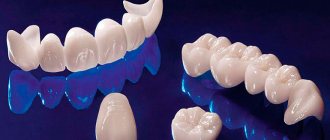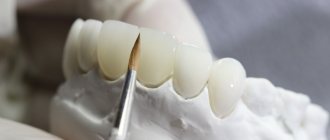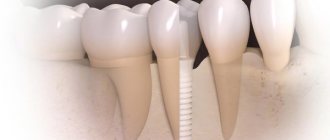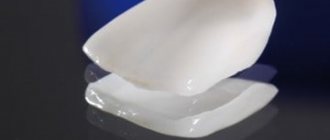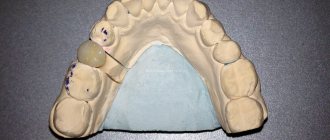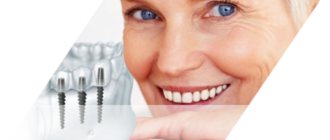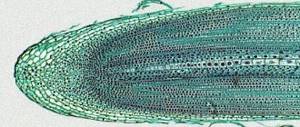Zircon and zirconium
The zircon mineral is a zirconium silicate with impurities of copper, iron, calcium, zinc, uranium, thorium, hafnium and titanium. It occurs in nature in the form of prismatic crystals, aggregates, grains, and differs in color and transparency. Pure zirconium oxide is refractory, has low thermal conductivity, is slightly soluble in water, and is resistant to chemical reagents.
Zirconium is an element of group IV of the periodic table with an atomic mass of 91.224. It exists in two forms - crystalline and amorphous. The highest concentration of the substance is in alkaline rocks. In nature, it is found in combination with silicate oxide - the mineral zircon or as free zirconium oxide - the mineral baddeleyite.
What is zirconium dioxide?
The raw material is a zirconium derivative (chemical formula - ZrO2). Zirconium is a natural mineral found in places where silicic acid salts occur, to which it actually belongs.
Zirconium dioxide is a durable and aesthetic material that has found application in many areas of medicine (for a long time it was used to create the heads of artificial joints). It has been used for the needs of orthopedic dentistry for more than 15 years.
Dentists are impressed by its rigidity, strength, and immunity to bending loads. Therefore, as a prosthesis, it simply has no price. For greater durability, it is enriched and stabilized with additional components (aluminum, yttrium).
Production and production of zirconium oxide
The minerals zircon and baddeleyite contain impurities of various metals, which give them their characteristic color, as well as impurities of uranium and thorium radionuclides, which make them radioactive. Therefore, they cannot be used in dentistry in their original form. Zirconium oxide is produced chemically and is highly pure. After complex purification from impurities, it becomes suitable for use as a ceramic biomaterial.
Zirconium oxide exists in the form of monoclinic, tetragonal and cubic crystalline phases. When heated, it transforms from one phase to another with a decrease in volume. To stabilize the condition, stabilizing oxides of calcium, magnesium, cerium, and yttrium are added to it.
Exceptional physical and mechanical properties are observed in ceramics based on zirconium oxide, partially stabilized with yttrium oxide. This material has record bending strength and excellent crack resistance.
For the industrial production of zirconium dental crowns in orthopedic dentistry, highly purified partially stabilized zirconium oxide powder is used. There are two possible options for processing it.
- Cold isostatic pressing.
The result is chalk-like, unfired ceramic blocks of high density (95% of theoretical). They can be thermally treated again under oxygen in a special non-pressure furnace to produce blocks in a pre-sintered state ("soft" zircon). For a fully sintered state, or “hard” zircon, the processing temperature should be not 1000, but 1500 °C.
- Hot isostatic pressing.
The result after sintering is ceramic blocks with a density of 100%. Removal of residual porosity occurs at a pressure of 1000 bar and a temperature that is 50 °C lower than the sintering temperature. The blocks are grayish-black in color, so additional oxidation is carried out to restore whiteness. Such blocks are more durable.
Zirconium dioxide: criticism and facts
Peter Yanev, dental technician (Plovdiv, Bulgaria)
I will try to explain why zirconium dioxide has become my favorite material when it comes to solving complex aesthetic problems using prosthetics. We will also consider examples of critical statements in relation to this excellent material and try to figure out whether such assessments coincide with reality.
I will briefly list the properties and advantages of zirconium from the practical side:
- Biological compatibility is a property that hardly needs detailed explanation. To date, there have been no reports of any allergic reactions caused by zirconium dioxide;
- Exceptionally high strength - with this material we can successfully produce the same work that we do with metal;
- Aesthetics - these days it is no longer enough for a patient to “just have something to chew.” Patients are paying more and more attention to appearance.
Zirconium dioxide is a material that successfully combines all these qualities and meets modern requirements. How do I choose zirconium in my daily practice? Let's start with the "foundation" and gradually move towards the "roof".
Stump inlays
Can we use zirconium dioxide to make them? Definitely yes. Thanks to its strength and transparency, we obtain both a strong and highly esthetic basis for the subsequent all-ceramic restoration (Fig. 1).
Figure 1a
Figure 1b
Figure 1c
There have been critics who argue that, due to its relatively reduced modulus of elasticity, the zirconia inlay can cause cracks and fractures in the root of the tooth being restored, acting like a wedge on the more flexible natural hard tissue. In fact, it is the reduced elasticity combined with the exceptional strength that makes the zirconia core inlay strengthen the tooth root. Of course, to achieve this, proper preparation of hard tissue is necessary: sufficient thickness (at least 1/3 of the total root cross-section) and pin length (at least 2/3 of the total root length). It is also necessary to provide a circular platform in the cervical part of the root, to which the coronal part of the core tab will fit tightly, thus limiting the wedging effect on the underlying tissues (dentin, cement).
Abutments for implants
Another area of application in which zirconium dioxide has proven itself, especially when it comes to restoring the frontal group of teeth (Fig. 2).
The zirconia abutment is the basis for a highly esthetic result. Excellent biocompatibility and polishability have made zirconia a particularly suitable material for the manufacture of superstructures.
Figure 2
Frameworks for crowns and bridges
This is the main application of zirconium in my daily work (Fig. 3). It is in this area that there are most of the unfounded fabrications on the part of opponents of this excellent material.
Figure 3
Questionable strength (chips and fractures)
The origin of the zirconium blocks plays an important role here.
Famous manufacturers bring to the market only certified high quality products.
However, many “suitcase merchants” (as we call them in Bulgaria) have appeared who offer goods of unknown origin, without a guarantee of quality or any documentation, and at a dubiously competitive price.
Designing the future frame
It is necessary to take into account all factors that may affect the final strength of the prosthesis: the size of the structure, the number and volume of the intermediate/cantilever part of the bridge; thickness of the caps; cross-section of connections between frame elements.
Another factor influencing the strength of the product is the process of milling the zirconium frame itself and its subsequent machining. If the technician does not have his own ZrO2 milling system, he must carefully choose who to entrust the production of zirconium frameworks to. Here the responsibility lies not only with the equipment, but also with the operator who operates it. After all, the operator is the person who sets the parameters of the equipment, the one on whom the final appearance, precision of fit and quality of the prosthesis largely depend. From the CAD/CAM center we receive a frame ready for subsequent manipulations, which requires almost no additional mechanical processing (Fig. 4).
Figure 4a
Figure 4b
Unfortunately, our practice is replete with examples of unsatisfactory results resulting from insufficiently well-trained operators operating CAD/CAM systems (Fig. 5). In this case, serious additional processing of the zirconium frame is required, which wastes time and negatively affects the quality and strength of the finished work.
Figure 5
Of course, the correct additional processing, namely the use of burs for zirconium, the absence of overheating of the material during milling, and mandatory subsequent firing, may well minimize the risk of cracks, chips and fractures.
Connection with ceramic layer
Recently, there have been a lot of critics who unanimously say that there is no chemical bond between zirconium dioxide and the ceramic coating and therefore chipping or splitting can occur. The strange thing is that in my practice and in the practice of colleagues with whom I know, there have been no such cases. Where is the truth? After careful scientific research, it was found that the bond between the zirconia framework and the ceramic is stronger than the similar bond between the metal and the ceramic (which is both mechanical and chemical). The reason is simple: the metal, unlike zirconium, has a significantly higher modulus of flexibility compared to the flexibility of sintered ceramics. Even minimal bending of the metal frame leads to the formation of cracks in the ceramic precisely because of the extremely low, almost non-existent elasticity. Zirconium dioxide, in turn, thanks to its exceptional strength and reduced elasticity, provides a stable and healthy base for ceramic veneers.
It is necessary to follow the rules for processing the material:
- avoid the presence of sharp edges and corners on the surface of the frame;
- provide space for a relatively uniform layer of ceramics;
- observe slow cooling after firing (up to 600 °C), especially for large structures.
Such ceramics can be separated from the finished prosthesis only by sawing/milling.
Unsatisfactory aesthetic results
Many critics argue that zirconia does not have good optical properties: transparency is insufficient and there is almost no fluorescence. Recently, it has been very fashionable to talk about the transparency of certain ceramic materials. But how much transparency do we really need? This depends on the type of structure, volume of material and area of prosthetics. If we are talking about a classic veneer, 0.3-0.5 mm thick, then we choose a material with better transparency, and this is due to the fact that it is mainly the enamel layer that is being restored. When it comes to bridge frames, things are different: the total thickness of the material (frame + ceramic) will be 1.2-2.5 mm. It must be remembered that the greater the transparency of an object, the more light passes through it and the less is reflected. But we see an object precisely thanks to reflection. The same is true for color rendering and perception. Thus, the transparent object is less noticeable and appears gray and colorless in the mouth.
Have you heard of a patient who would love this?
Another advantage is that due to the optimal transparency of zirconium, we can hide any defects in the tooth core (discoloration, metal pins) by using different frame colors and varying the thickness of the caps.
Thus, there is no need for maximum transparency: for the manufacture of frameworks, we need a material with optimal translucency close to natural dentin, which is what modern zirconium dioxide gives us.
What else does aesthetics depend on?
From the choice between white and colored zirconium, which is directly related to the ceramic system you use. In some ceramic systems, a special layer is necessarily applied on top of zirconium dioxide - bonding (often such masses have quite significant opacity), which worsens the optical properties of the finished prosthesis. The ceramic manufacturer usually recommends that owners of such systems work with white zirconium frames (Fig. 6).
Figure 6
I use only colored zirconium because the Vita VM9 ceramics I use do not require a special bond type material. When using VM9 as a bonding agent, a thin layer of Wash BASE DENTIN is applied to the surface of the zirconium framework (Fig. 7). After firing, no loss of transparency is observed.
Figure 7a
Figure 7b
Fluorescence
Zirconia does exhibit reduced fluorescence, but this is not a problem with modern ceramic systems. Most ceramic materials have varying degrees of fluorescence depending on their intended use. The kits contain specially developed fluorescent masses, thanks to which we have complete control over the fluorescence, since we are able to recreate it to the level we need. In Figure 8 we see zirconium caps on teeth 13 and 12. The cap of tooth 11 is coated with fluorescent material EFFECT LINER; 21, 22 and 23 are coated with the aforementioned Wash BASE DENTIN.
Figure 8
The esthetics of each all-ceramic prosthesis depends to a certain extent on the choice of cement. The market offers a wide range of luting cements, which I do not intend to dwell on in detail. From an aesthetic point of view, cement must be selected based on its transparency, degree of brightness and color in each specific case. It should be noted that, unlike thin veneers, prostheses with a zirconia framework are less sensitive and allow some freedom in the choice of cement. The correct choice of material for fixation allows you to correct minor color discrepancies in the finished structure. On the other hand, the “wrong” cement (often with a high degree of opacity and light blocking) is quite capable of ruining a perfect job.
In conclusion, if the fundamental principles of proper planning, fabrication and fixation are followed, zirconium is truly an excellent material for making frames. It allows us to fully control every stage of creating a precise, durable and highly aesthetic orthopedic design.
Indications and contraindications for installation
Crowns are used not only in orthopedic structures, but also in implantation. It is recommended to use it in the following cases: severe tissue damage (usually with advanced caries), unsuccessful restorations using old prosthetic methods or the use of low-quality materials for an aesthetic appearance, prosthetics with zirconium oxide if a person has an allergic reaction to metals.
Typically, crowns are not placed on back teeth. This is not necessary, since they are not visually noticeable and do not require an aesthetic appearance. Therefore, dentists can offer a simpler option for prosthetics.
Contraindications to installing a zirconium dioxide crown: deep bite, low tooth height, bruxism, inflammation in the oral cavity, decreased immunity, psychological disorders.
Crowns have virtually no contraindications. Therefore, they are recommended to be used in most cases.
Advantages and disadvantages
The use of crowns is popular in modern orthodontics. The base is reliable and durable. The lining is made with porcelain paste. Advantages of crowns:
- practically no different in appearance from a natural tooth;
- strength, stability (allows you to wear them for a long time);
- can be used for front or back teeth;
- safe for periodontal disease;
- are not harmful to the human body;
- the thickness is small, so no turning is required;
- resistance to cracking;
- replace a front tooth;
- does not affect the bite, has high fixation;
- reducing the risk of inflammation under the structure;
- lack of sensitivity to thermal factors (zirconium oxide is a well-known heat insulator);
- there are no visual signs of prosthetics;
- tend to retain their original appearance for more than 20 years.
Crowns of this type have few disadvantages. This is mainly due to the high cost and complexity of manufacturing. Such work can be considered jewelry. They are usually made by a dental technician. Many patients are scared by the price of such crowns. Cheaper dentures are not as durable or reliable. They may need to be replaced soon.
In most cases, zirconium dioxide crowns are installed once and for life. Therefore, you should not save on your own health.
Frameworks made of dental metal alloys
The frame for the metal-ceramic structure is made of alloys of cobalt and chromium, nickel and chromium, and precious metals are also used - gold, platinum, palladium. The thickness of the base is from 0.3 to 0.5 mm; together with the ceramic layer, the thickness of the prosthesis is about 1.5-2 mm.
Unlike composite materials, which are also used for the restoration of crowns, and are much cheaper, ceramics reproduce the color and structure of natural dental tissue, while it does not fade or absorb dyes.
A metal-ceramic dental crown is a good option if you need to restore your chewing teeth aesthetically and reliably and you are not allergic to metals. Metal-ceramic prostheses have the following advantages:
- Good aesthetic indicators. High-quality artificial metal-ceramic crowns are practically no different in appearance and functionality from natural teeth;
- Durable, able to withstand high chewing loads, can last more than 10 years;
- The design retains its original color throughout the entire period of use;
- Possibility of prosthetics for any teeth;
- In case of minor damage to the crown, it can be restored;
- Affordable cost of products;
- Resistance to loads;
- Good hygienic indicators.
But metal-ceramic dentures have some disadvantages:
- In cases where the ceramic layer is damaged (anything can happen), a metal frame may appear through the resulting cracks and chips;
- To install metal-ceramics, in most cases it is necessary to remove the pulp and significantly prepare the biological crown (about 2 mm on all sides);
- In some cases, over time, cyanosis of the mucous membrane may occur at the junction of the crown and the gum;
- The frame material does not transmit light, so at certain lighting angles, the metal can be visible through the ceramic coating. For this reason, installing metal-ceramic crowns on the front teeth is not suitable for all patients.
Physicochemical characteristics
Zirconium is a shiny silver-gray metal. Exists in three crystal modifications, α, β and ω:
- α-Zr - hexagonal system, space group P
63/
mmc
, cell parameters
a
= 0.3231 nm,
c
= 0.5146 nm,
Z
= 2,
d
= 6.5107 g/cm3 with a close-packed magnesium-type lattice. - β-Zr - cubic system (body-centered lattice), space group Im
3
m
, cell parameters
a
= 0.361 nm,
Z
= 2 with an α-Fe lattice.
The α ↔ β transition occurs at 863 °C, Δ H
transition is 3.89 kJ/mol [2]. Additives , , , increase, and , , , , , , , , and lower the transition temperature [2]. - ω-Zr is a metastable hexagonal phase that appears at high pressures, which is not close-packed and has three atoms per unit cell [9].
The density of α-zirconium at 20 °C is 6.5107 g/cm³; melting point T
pl = 1855 °C[2];
boiling point T
boil = 4409 °C; specific heat capacity (25-100 °C) 0.291 kJ/(kg K) or 0.0693 cal/(g °C), thermal conductivity (50 °C) 20.96 W/(m K) or 0.050 cal /(cm s °C); temperature coefficient of linear expansion (20-400 °C) 6.9·10−6; electrical resistivity of high purity zirconium (20 °C) 44.1 μΩ cm. The temperature of transition to the state of superconductivity is 0.7 K[10].
Zirconium is paramagnetic; The specific magnetic susceptibility increases with heating and at −73 °C it is 1.28·10−6, and at 327 °C it is 1.41·10−6. The thermal neutron capture cross section is 0.18·10−28 m² (0.18 barn), the hafnium admixture increases this value, so zirconium, well purified from hafnium, is used for the manufacture of fuel rods. Pure zirconium is ductile and easily amenable to cold and hot processing (rolling, forging, stamping). The presence of small amounts of oxygen, nitrogen, hydrogen and carbon dissolved in the metal (or compounds of these elements with zirconium) causes the fragility of zirconium. Elastic modulus (20 °C) 97 GN/m² (9700 kgf/mm²); tensile strength 253 MN/m² (25.3 kgf/mm²); Brinell hardness 640-670 MN/m² (64-67 kgf/mm²); The oxygen content has a very strong influence on the hardness: at a concentration of more than 0.2%, zirconium cannot be cold worked.
The external electronic configuration of the zirconium atom is 4d25s2. Zirconium has an oxidation state of +4. Lower oxidation states +2 and +3 are known for zirconium only in its compounds with chlorine, bromine and iodine.
Compact zirconium slowly begins to oxidize within 200–400 °C, becoming covered with a film of zirconium dioxide ZrO2; above 800 °C interacts vigorously with oxygen in the air. Powdered metal is pyrophoric - it can ignite in air at ordinary temperatures. Zirconium actively absorbs hydrogen already at 300 °C, forming a solid solution and hydrides ZrH and ZrH2; at 1200–1300 °C in a vacuum, the hydrides dissociate and all hydrogen can be removed from the metal. With nitrogen, zirconium forms ZrN nitride at 700–800 °C. Zirconium reacts with carbon at temperatures above 900 °C to form ZrC carbide. Zirconium carbide and zirconium nitride are solid, refractory compounds; zirconium carbide is an intermediate product for the production of ZrCl4 chloride. Zirconium reacts with fluorine at ordinary temperatures, and with chlorine, bromine and iodine at temperatures above 200 °C, forming higher halides ZrHal4 (where Hal is a halogen).
Zirconium is stable in water and water vapor up to 300 °C; at higher temperatures (starting from approximately 700 °C) an exothermic zirconium-steam reaction begins
Z r + 2 H 2 O → Z r O 2 + 2 H 2 ↑ {\displaystyle {\mathsf {Zr+2H_{2}O\rightarrow ZrO_{2}+2H_{2}\uparrow }}}
which is important in the development of accidents in nuclear reactors with water coolant and/or moderator[11].
Does not react with hydrochloric and sulfuric (up to 50%) acids, as well as with alkali solutions (zirconium is the only metal that is resistant to alkalis containing ammonia). It reacts with nitric acid and aqua regia at temperatures above 100 °C. Dissolves in hydrofluoric and hot concentrated (above 50%) sulfuric acids. Salts of the corresponding acids of different compositions, depending on the concentration of the acid, can be isolated from acidic solutions. Thus, Zr(SO4)2·4H2O crystalline hydrate is precipitated from concentrated zirconium sulfate solutions; from dilute solutions - basic sulfates of the general formula x
ZrO2
y
SO3
z
H2O (where
x
:
y
> 1).
Zirconium sulfates at 800–900 °C completely decompose to form zirconium dioxide. Zr(NO3)4 5H2O or ZrO(NO3)2 x
H2O (where
x
= 2–6) crystallizes from nitric acid solutions; ZrOCl2 8H2O crystallizes from hydrochloric acid solutions, which is dehydrated at 180–200 °C.
Installation process
A zirconium dioxide crown can only be installed according to the following plan:
- At the first appointment, the doctor examines the condition of the patient’s teeth, establishes a diagnosis of diseases, if any;
- grinds teeth to install a zirconium dioxide crown (done under local anesthesia);
- takes impressions and places temporary plastic crowns (they are installed while the permanent zirconium dioxide crowns are being prepared);
- the color is selected individually for each patient, taking into account the shade of natural teeth;
- In the laboratory, a computer program produces crowns from zirconium oxide, which are then fixed in the oral cavity.
Proper care of zirconium crowns
Zirconium dioxide crowns do not require special care. It is enough to perform hygiene procedures: brush your teeth 2 times a day, use floss and mouthwash. Using an irrigator is also considered useful.
After each meal, it is recommended to rinse your mouth with warm water. A sodium dioxide crown requires the same care as natural teeth. In addition, you should avoid eating solid foods and limit the influence of mechanical factors. It is forbidden to bite hard objects.
A crown based on zirconium dioxide requires not only hygienic care, but also careful treatment. A routine examination by a dentist should be carried out 2 times a year, then the prosthetics will last a long time.
How are zirconium dioxide crowns made? How long does it take to produce?
Zirconium crowns and dentures come in two layers. Inside is a very strong zirconia base, lined with porcelain and fired until both materials are sintered together.
The process of making crowns is labor intensive and takes 1 to 2 weeks. At the first stage, the doctor in the clinic takes an impression of the patient’s jaws and hands it over to the dental technician. A three-dimensional model is made from plaster. The further process of creating prostheses from this material is computerized.
CAD/CAM technology is used. A laser scanning of a plaster model created from a cast is carried out. The data is transferred to a special program that allows you to simulate the desired characteristics of a future crown or bridge and see how they fit into the dentition.
After the design is approved, the turning task is transferred to a milling machine, which produces the prosthesis from a zirconium dioxide workpiece in exact accordance with the plan. With the help of digital technologies, it is possible to create the thinnest lightweight material, which is especially convenient for use in prosthetics of the entire jaw.
The finished frame is covered with several layers of porcelain, firing it layer by layer in an oven at high temperature until the material is sintered. This achieves high strength and indivisibility of the structure. Subsequently, the crown is painted with a special dye and takes on a finished appearance.
Advantages of zirconium crowns over metal-ceramics
If prosthetics are necessary, the patient is faced with the question of which artificial teeth to choose. Zirconium oxide has many advantages over other materials:
- Prosthetics with zirconium crowns do not require nerve removal.
- Lack of metal in the design, which eliminates problems such as allergic reactions and metallic taste in the mouth.
- Guaranteed absence of disease development under the crown. The denture fits tightly to the gum, food particles and bacteria do not get under it.
- Accuracy of frame execution. Digital data processing guarantees incredible precision in the manufacturing of the structure.
- Individual color selection. The finished prosthesis cannot be visually distinguished from other healthy teeth.
- Possibility of manufacturing a bridge of any length;
- Lightness of design.
- Lack of reaction to cold and hot food. Wearing metal ceramics may cause discomfort due to high or low temperatures. Zirconium oxide does not give such a reaction.
- Absolutely natural appearance.
- Absence of a gray border in the area of contact with the gum.
- When preparing for prosthetics, there is no need to heavily grind the tooth.
- Crowns do not deform and retain their appearance and shape for a long time.
Zirconium in its elemental form is a silvery-white metal with characteristic properties such as corrosion resistance and ductility. In nature it is quite common, but at the same time very scattered. Large deposits of it have not yet been found. People first learned about the possibility of the existence of this metal in 1789. Then the chemist M. Klaproth, while studying the mineral zircon, accidentally discovered its oxide. This metal was obtained in its pure form only in 1925. In the modern world, zirconium, the production of which is widespread, is used in a wide variety of industries. Of course, many domestic enterprises are also producing it.
Being in nature
Zirconium compounds are widespread in the lithosphere. According to various sources, the clarke of zirconium is from 170 to 250 g/t. Concentration in sea water is 5·10−5 mg/l[5]. Zirconium is a lithophile element. In nature, its compounds are known exclusively with oxygen in the form of oxides and silicates. Despite the fact that zirconium is a trace element, there are about 40 minerals in which zirconium is present in the form of oxides or salts. Most common in nature are zircon (ZrSiO4)(67.1% ZrO2), baddeleyite (ZrO2) and various complex minerals (eudialyte (Na, Ca)5(Zr, Fe, Mn)[O,OH,Cl][Si6O17] and etc.). In all terrestrial deposits, zirconium is accompanied by zirconium, which is included in zircon minerals due to the isomorphic substitution of the Zr atom.
Zircon is the most common zirconium mineral. It is found in all types of rocks, but mainly in granites and syenites. In Ginderson County (North Carolina), zircon crystals several centimeters long were found in pegmatites, and crystals weighing kilograms were discovered in Madagascar.
Baddeleyite was discovered by Yussac in 1892 in Brazil, the main deposit being in the Pocos de Caldas area. A block of baddeleyite weighing about 30 tons was found there, and in water streams and along the cliff, baddeleyite is found in the form of alluvial pebbles with a diameter of up to 7.5 mm, known as favas (from Portuguese fava
- bob). Favas typically contains over 90% zirconium dioxide[6].
Place of Birth
The largest zirconium deposits are located in the USA, Australia, Brazil, and India[7].
In Russia, which accounts for 10% of the world's zirconium reserves (3rd place in the world after Australia and South Africa), the main deposits are: Kovdorskoye primary baddelite-apatite-magnetite in the Murmansk region, Tuganskoye alluvial zircon-rutile-ilmenite in the Tomsk region , Central placer zircon-rutile-ilmenite in the Tambov region, Lukoyanovskoe placer zircon-rutile-ilmenite in the Nizhny Novgorod region, Katuginskoe primary zircon-pyrochlore-cryolite in the Chita region and Ulug-Tanzek primary zircon-pyrochlore-columbite.[8] Almost unlimited reserves of zirconium are concentrated in the alkaline syenites of the Khibiny massif on the Kola Peninsula, where this metal is part of many minerals, in particular eudialyte.
Types of crowns
Patients often confuse the ceramic look with porcelain. It all depends on the original material, so they are divided into the following types: zirconium dioxide crown, porcelain.
The latter type is recommended for installation in the case of a single restoration. In most cases, they are not used for bridge prosthetics. The ideal option for any case is zirconium dioxide crowns. They are suitable for all groups of teeth. The material has unique properties, even ceramic ones are inferior in quality. Zirconium crowns are in great demand.
